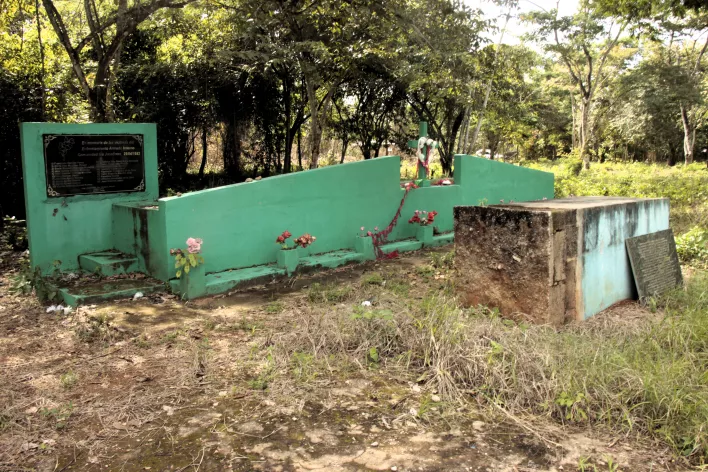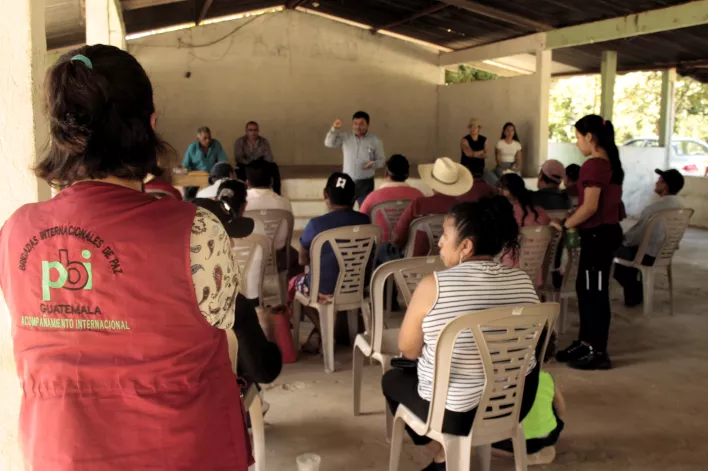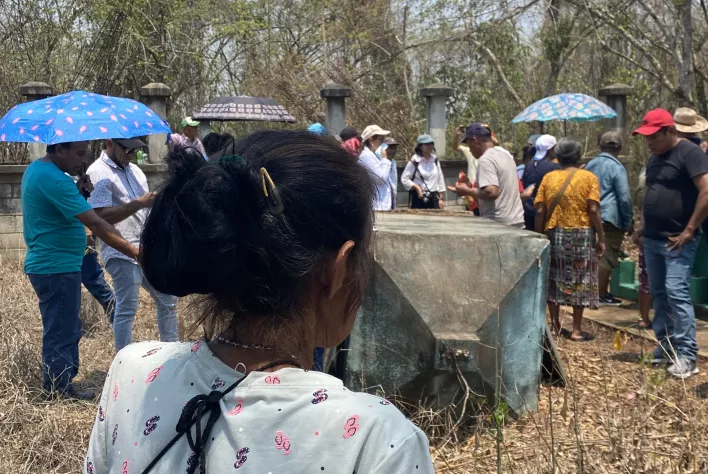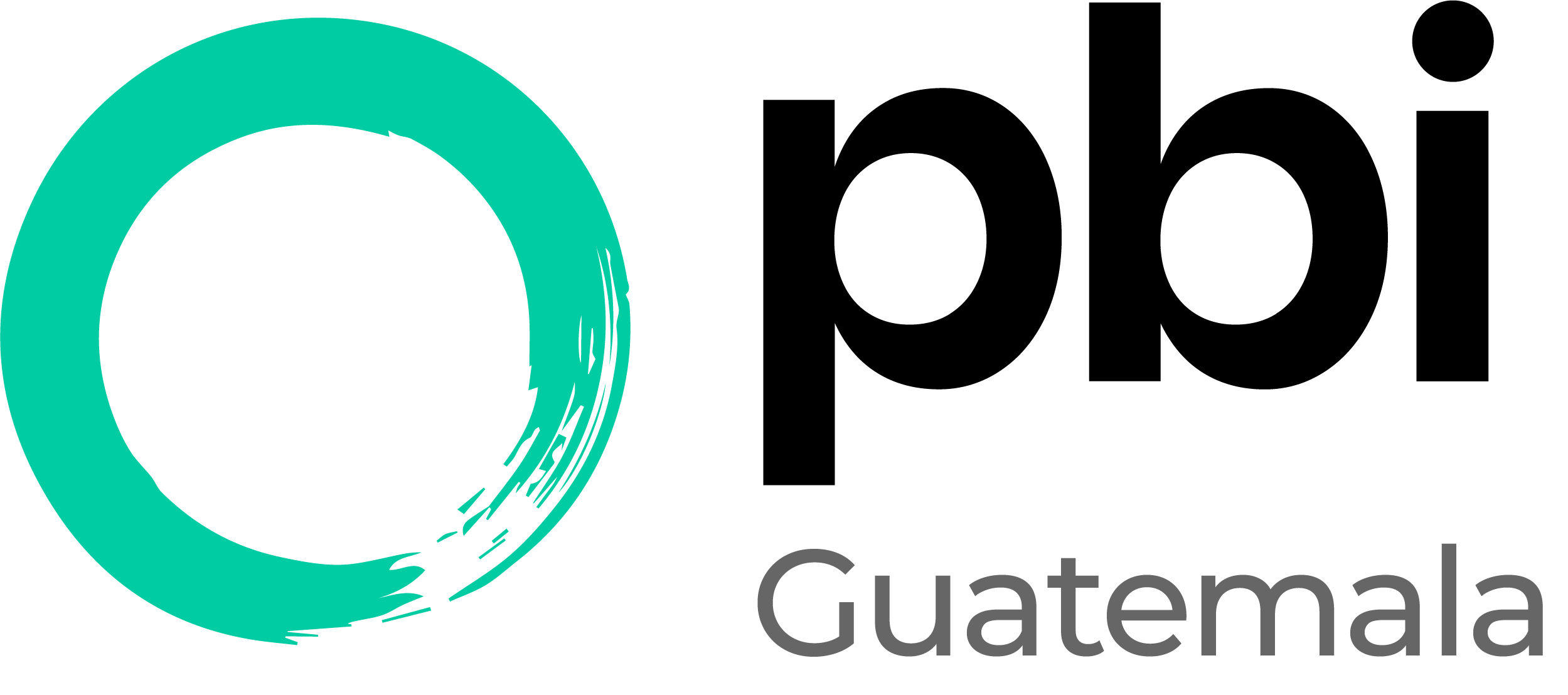
“We thank God that we are alive so that we can share what happened to us; what we suffered then is painful to remember. (1)
“On the night of April 29 and in the early hours of April 30, 1982,” in the context of the Internal Armed Conflict (IAC, 1960-1996) and one month after the coup d’état of March 23, 1982, (2) “members of the Guatemalan army entered and laid siege to the village of Los Josefinos, in the department of Petén. The military cruelly, violently and indiscriminately massacred a large number of the town’s inhabitants, including women and children. In their effort to completely destroy the community, they also caused massive destruction, killing animals and setting fire to houses, huts and other properties.”3 In the aftermath of these horrendous crimes, the survivors have continued to suffer from the trauma and from ongoing violations of their human rights such as forced displacement and its consequent sense of uprootedness, forced disappearance and lack of reparations. “Those of us who suffered it directly did not receive any support from the State, the government did not care about anything, instead we were persecuted, we were discriminated against, we were accused of being guerrillas and of many other things that we did not understand.” And of course they were stripped of their land: “lost my plot of land. When I left it was abandoned, then I returned, and it was already owned by someone else; he told me that the army had given it to him.”
Although 42 years have passed since the massacre took place, those who survived explain that “this pain does not go away” and that the story “is as vivid as if it had happened yesterday”.4 At the time of writing (2021), the Inter-American Court of Human Rights (I/A Court H.R.) has issued a final sentence against the State of Guatemala, but nine reparation measures have yet to be implemented. These include: the investigation and prosecution of the case; the continued search for disappeared persons; the return of displaced families; the provision of resources for the health center; the creation of a documentary about the events to preserve historical memory; the continued construction of the mausoleum to dignify the victims’ memory; and compensation for material damages. Each measure fulfilled is a guarantee of non-repetition. As one of the survivors points out, “there aren’t enough institutions, nationally and internationally, that come to learn about what the massacre was like.”

Background: living on one’s own land
The survivors remember what life was like before the massacre. According to their testimony, in the 1970s they lived happily in the village, because of the opportunities for farming. One man says that he planted corn and beans, and that beekeeping provided enough income for him and his family: “In my case, prior to the massacre I was not in need, that’s why I stopped going to school, because my goal was to have a piece of land, and I had achieved it.”
In the early years of the Carlos Arana government (1970-1974), a state agrarian development project was set up in the Petén, with the aim of “colonizing the department and generating agricultural development.” In the early years of the Carlos Arana government (1970-1974), a state agrarian development project was set up in the Petén, with the aim of “colonizing the department and generating agricultural development.” The official goal was to “populate these distant lands, build schools, roads, clinics and land so that the peasants” could “grow crops and promote development.” But according to information collected at the Nuevo Horizonte Museum, the real objective behind this campaign, intended to settle the peasant population in the region, was to use them as a human bulwark to prevent looting from the neighboring country, Mexico.
As a result, families from other parts of the country who needed land were encouraged to settle in Petén. “The peasants were thrilled to learn that they would be working their own land” on which they would plant crops and build their houses. At the end of 1972, the State, through the National Enterprise for the Economic Development of Petén (FYDEP), granted plots of land in the village of Los Josefinos, in the municipality of La Libertad. It was named Los Josefinos because the majority of the population came from Puerto San José, in the department of Escuintla.
Context: “That time is painful to remember”
This period of happiness lasted only a few years. At the beginning of the 1980s, many families were forced to flee and leave their land. On the morning of April 29, 1982, guerrilla members entered the village, held a rally and “executed” two men who, according to the guerrillas, were linked to the army.
As a result, in the afternoon there was a confrontation between the guerrillas and the army in a place near the village. At midnight the army entered the village and carried out the massacre. In addition to what was reported at the beginning of this article, according to one of the survivors, some of the women and girls were raped before being executed. To date, “there is no certainty about the identity and the total number of people who lost their lives as a result of these events.” The survivors remember how they fled with nothing but the clothes on their backs and scattered across different parts of the country, with some even going as far as Mexico. “The village was left desolate and practically abandoned. (…) Several families were separated while escaping, some reuniting years later,” while others, despite having been reunited “never managed to re-establish their family ties.”
One survivor recalls with horror what happened that April 29: “We were terrified by what had happened. That afternoon was an afternoon of anguish for us.” One woman, who was 28 at the time, said that she saw children clutching the hands of people who were on fire. She had four children and lost them all. Another woman, who was 13 years old, explains that she was studying at the time, but after the massacre she was unable to continue because her family lost everything, and she was forced to start working. The material, psychological and emotional conditions in which the survivors found themselves were very difficult.

The Los Josefinos massacre was part of the counterinsurgency strategy of terror, racism and stigmatization carried out by the State during the IAC. During that time, mainly between 1978 and 1982, the army deployed excessive violence with total impunity against people, organizations and communities considered “internal enemies.” Forced recruitment, the militarization of communities, torture, sexual violence, kidnapping, forced disappearances and forced displacement, arbitrary executions and the massacres of predominantly Maya peoples and communities (scorched earth policy) were common practices. In fact, 93% of the rapes documented by the Commission for Historical Clarification (CEH) were committed by state forces and associated paramilitary groups. The aim of such brutal repression was to subdue, discipline and make an example of the population through fear, impunity and silence.(3)
Between 1982 and 1985, 23 families who survived this massacre returned to the Los Josefinos community, which was under the control of the army, who had divided up the land. According to the Association of Relatives of the Detained and Disappeared of Guatemala (FAMDEGUA), “the army designated a specific location for them, a piece of land where they could live,” and until 1996 members of these families were forced to participate in the Civil Defense Patrols (PAC) and had to live under the control of the army. (4)
The long road to justice
At the end of the IAC, FAMDEGUA began to support some of the families who survived the Los Josefinos massacre. FAMDEGUA’s then director, Aura Elena Farfán, (5) encouraged them in their search for justice: “face it, speak out, discuss it, tell the truth.” AMDEGUA represented the victims and later became a plaintiff in the case.
On January 16, 1996, FAMDEGUA reported the events to the Court of First Instance of the Department of Petén. In March of that same year, the Guatemalan Forensic Anthropology Foundation (FAFG) exhumed the remains of the people massacred, to gather preliminary evidence for the complaint. Nineteen skeletons were exhumed: five children between one month and eleven years old, one adolescent between twelve and eighteen years old and twelve adults. Based on the state of the skeletons and the 27 bullet casings found, FAFG determined that “these people’s deaths were violent, legally classified as homicide in every case.” “All the skeletons spoke of sadness, pain and silenced memory.” (3) The following month, the Public Prosecutor’s Office (MP) opened an investigation to determine the facts.

Faced with a lack of progress in the investigation and prosecution of the case in Guatemala, FAMDEGUA and the survivors, took the case to the Inter-American Human Rights System, with the legal support of the Center for Justice and International Law (CEJIL). On October 27, 2004, they filed the petition with the Inter-American Commission on Human Rights (IACHR), and 15 years later the case was brought before the I/A Court H.R.
On November 3, 2021, the I/A Court H.R. declared the State of Guatemala responsible for the forced disappearance of 14 people, the forced displacement of 7 people and their families (49 people in total) and “the violation of the rights to judicial guarantees and judicial protection against the relatives of the victims of the massacre, the victims of forced disappearance and their relatives, and the surviving victims of the massacre.” It also made recommendations to the State for reparations measures.
Three years after the sentence, FAMDEGUA continues to work on identifying victims. The I/A Court H.R.’s subsequent review of the sentence, published in November 2023, recognizes 76 surviving victims and gives new momentum to the fight for compliance with the 2021 recommendations. FAMDEGUA members are disappointed that state institutions are not cooperating to comply with these recommendations: “We are really doing the investigation that the MP should be doing.” They have set about the task of “locating the relatives and taking statements about the events that each of them experienced.”
FAMDEGUA believes that the terrible impacts of the massacre are being passed on to the next generations, as the survivors and their children, grandchildren and great-grandchildren continue to suffer from the lack of justice and live in very difficult conditions, all made worse by the lack of support from state institutions. In the face of this lack of response, many relatives of the survivors emigrated to Mexico and the United States in search of better living conditions. Even the I/A Court H.R., faced with the lack of reparations by the State, anticipated these consequences for future generations and, according to FAMDEGUA members, recognized them as victims “because they are still suffering the effects of forced displacement. It is no longer just the parents; it is also their children. The outlook for the families is very complex.”
One of the survivors we were able to talk to highlighted the lack of support from state institutions and delays in the legal process: “The state has not bothered to set up search committees, and the MP has done even less to investigate the intellectual authors of the massacre. They appoint one prosecutor after another, and if a prosecutor makes a little progress in the investigation, they take him away and appoint another. They do it to obstruct justice.”
Despite all the obstacles and challenges, the survivors, along with organizations like FAMDEGUA and CEJIL, have mobilized to continue demanding that the State of Guatemala comply with the reparation measures.
“The memory of the massacre is painful and persistent”
Speaking about the impact of these horrendous events, one survivor explains that they were not only material, but also psychosocial. She says that two of her children were killed and that she cannot cry, “there’s so much pain in my heart, I can’t let it go.” She suffers anxiety attacks and her whole body goes rigid. She shares that she likes the idea of making a documentary about the massacre, as mentioned in one of the recommendations, because she doesn’t want anything like what happened to her to ever happen again.
There is a total lack of medical and psychosocial support for the survivors, which the State has an obligation to provide. “They made a commitment to provide a psychologist to care for all the victims of the Josefinos. They had to meet this need, wherever the survivors were. But the psychologist is from another community health center and only comes once a week with the doctor, and the State claims that this is how it is fulfilling its commitment.” Furthermore, the I/A Court H.R. has ruled “against the State of Guatemala, pointing out its ineffectiveness in terms of providing solutions and guaranteeing surviving victims’ right to justice.”

“Nosotros como víctimas pedimos que se cumpla todo de la sentencia y que sea pronto porque la mayoría de víctimas estamos muriendo.”
On top of all this, there are other problems affecting the community, such as land in the hands of soldiers, monocultures of teak trees and young people migrating to the United States in search of work and better living conditions. According to FAMDEGUA, “the same structures that continue to displace and dispossess people of their lands” are still in place. The recurring issue of land distribution and ownership and structural economic and social inequalities continue to persist and strongly impact the survivors. One community leader concludes that “before, you could grow anything, cassava, sweet potatoes, yams, pineapples… but now the rich have the land.” For all these reasons, the outlook for the families of the Josefinos is difficult and complex. The road to justice and a dignified life has been long and complicated, but together with FAMDEGUA they will continue to struggle to achieve it.
1 Direct quotes in this article that do not mention another source were gathered during a meeting that took place in the village of Los Josefinos, as part of an accompaniment we provided to the Association of Relatives of the Detained and Disappeared of Guatemala (FAMDEGUA) on April 29, 2024. At this meeting, massacre survivors, who are still seeking justice, shared their feelings with us.
2 This coup marked the beginning of the de facto presidency of José Efraín Ríos Montt, twice convicted of genocide against the Ixil people, committed during the 16 months he remained in power until he was ousted by another coup d’état on August 8, 1983.
3 Sanford, V., Dill, K., y Duyos, S., “Guatemala: violencia sexual y genocidio”. F&G Editores, Guatemala 2020.
4 This, and all the quotes from FAMDEGUA members that appear in this article, were drawn from an interview we conducted with three members of FAMDEGUA on 25 July 2024.
5 Human rights defender and founder of the Mutual Support Group (GAM) in 1984 and FAMDEGUA in 1992, dedicated to supporting the families of detained and disappeared people during the IAC.
